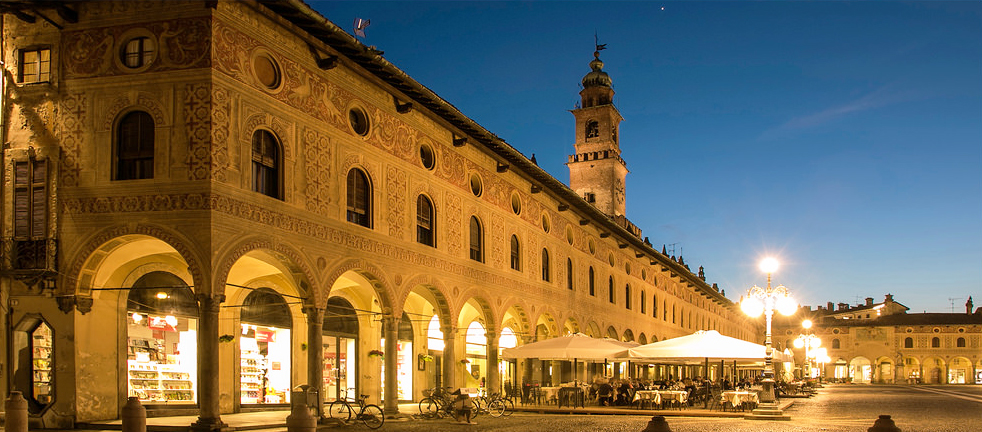an enchanted city in the Lomellina area

Let me tell you the story of the city where I was born, Vigevano.
Vigevano is part of the province of Pavia and it has around 64000 inhabitants, a number that keeps growing each year. Its origins, although confused, date back to 963, when Vigevano was mentioned for the first time in a manuscript with the name of Vicocogebuin.
The city was born on the banks of River Ticino in a completely flat area. In that period, and until the 12 th century, Vigevano was at the centre of the sanguinary conflicts between Pavia and Milano that wanted to conquer the territory as it is located exactly halfway from both the big cities. These battles lasted for years and years, until, around 1400, the city was given to the Visconti and then to the Sforza families. In this period, Vigevano experienced a period of splendor, becoming the Duke’s family residence and a trade center for wool and linen.
Another highlight of the city was the building of the wonderful Piazza Ducale wanted by Ludovico Il Moro, who also became Duke of Milan in those years. He wanted to decorate his home town, so, after building Piazza Ducale, that was ended in 1494, he improved the entire Vigevano area and its irrigation system with benefits for the agricultural activity and built a model of a farm, called Sforzesca, right outside the city center.
After this phase of magnificence and after the capture of Ludovico il Moro, there was a long period of battles and foreign occupations. After being under Spanish domination for around a hundred years, between 1700 and 1745 the city was ruled by the Austrian. Finally, after the Austrian domination, the city went back to being part of the Kingdom of Sardinia.
From 1814 on, Vigevano was still ruled by the Savoia family and after the battle between the inhabitants of Piedmont, who won, and the Austrian, the industrial age began. The railway lines connecting Vigevano to Mortara and Milan were opened and in 1866 the first Italian shoe factory (Bocca Luigi) was born.
In about 40 years the footwear industry expanded, on such a big scale that 13000 people were employed in this field, reaching incredible levels in 1965 when 1 in 2 people worked in a shoe factory, in the amount of 20009 workers. Along with the footwear industry, textile companies were also successful, especially those that manufactured silk and cotton. After the second world war, the textile field went into decline and the success of the footwear industry, after the big boom in the ‘50s and ‘60s, dropped dramatically.
The historical places you need to visit are piazza Ducale, that draws in tourists from the whole world, the different churches and buildings in the old town center, for example Chiesa di San Pietro Martire, Chiesa di San Francesco, Palazzo San Severino and Palazzo Crespi.
Besides architecture, Vigevano offers a wide range of famous pubs and restaurants where you can taste typical products and dishes from the Lomellina area.
In the last few years, Piazza Ducale, that started getting ignored due to the previous municipal authorities’ poor choices, is now going back to being fashionable and elegant as it was before. Finally restaurateurs started investing again in Piazza Ducale, which is the at the heart of the city of Vigevano. In the square and in the Castle of Vigevano, events at a national and European level, exhibitions, concerts and events that attract tourists take place and improve each year despite the economic crisis.
I personally think that Vigevano, like many old cities, has a strong tourist potential, even if it has not been developed at its best yet.
So, if you are looking for a magical place to visit, that is not too chaotic so that you can spend a relaxing weekend between art and nature, Vigevano is the right place for you!
By M. Baronchelli
Leave A Comment